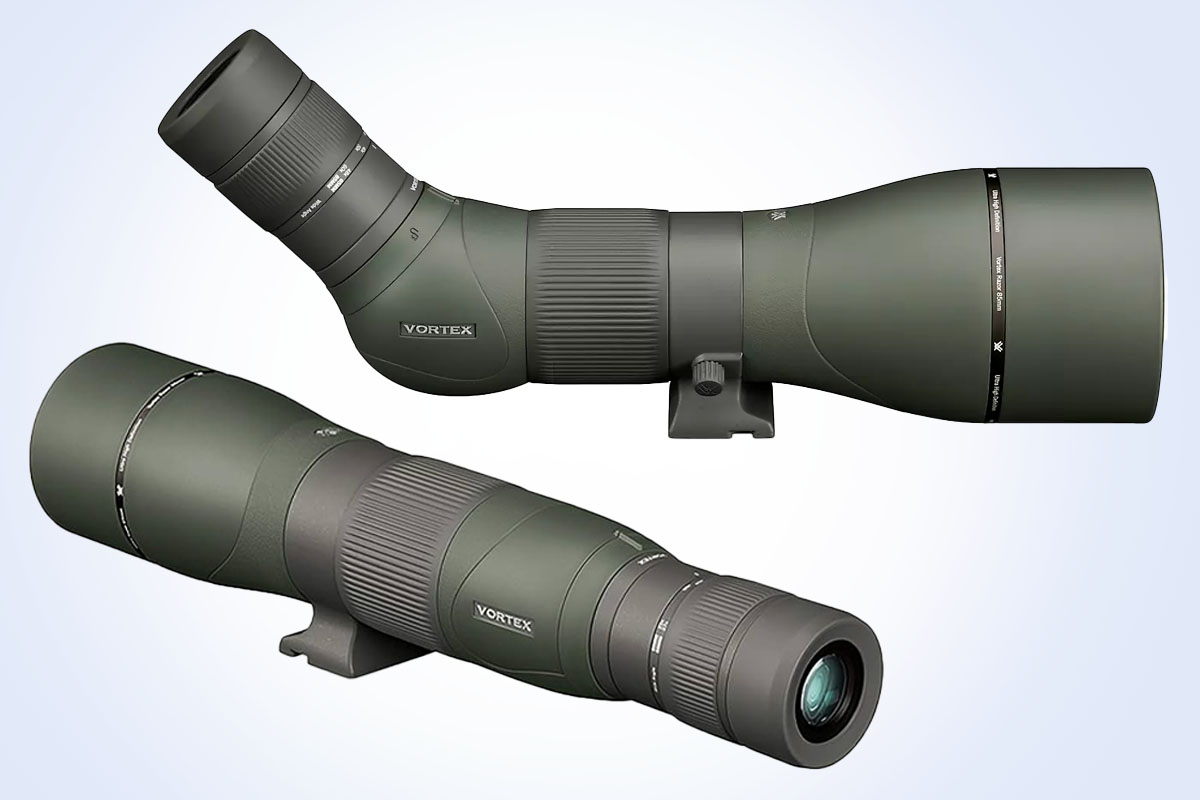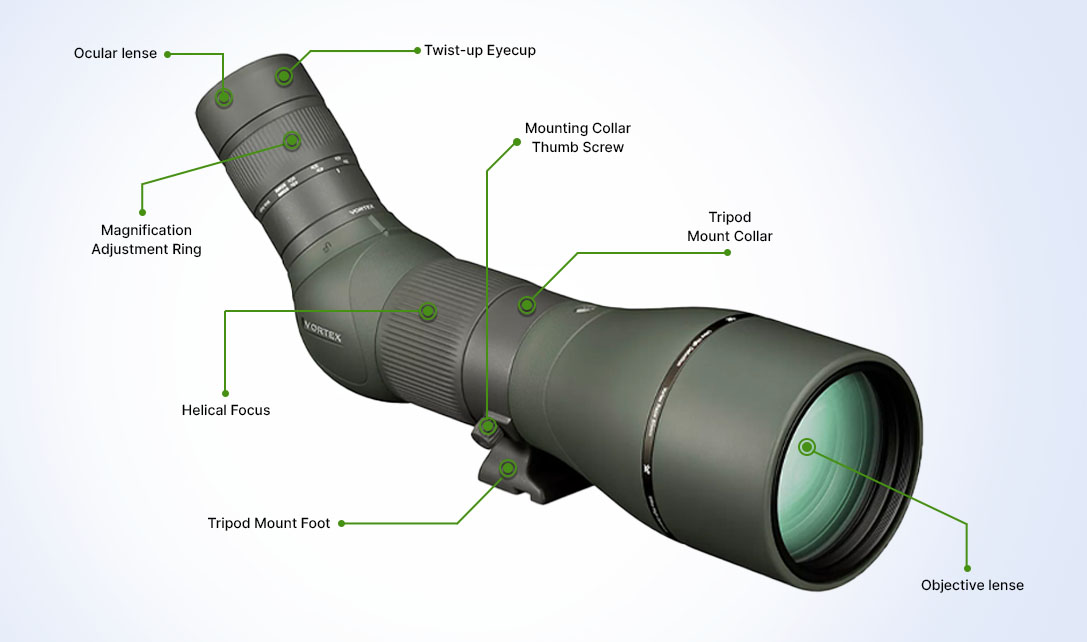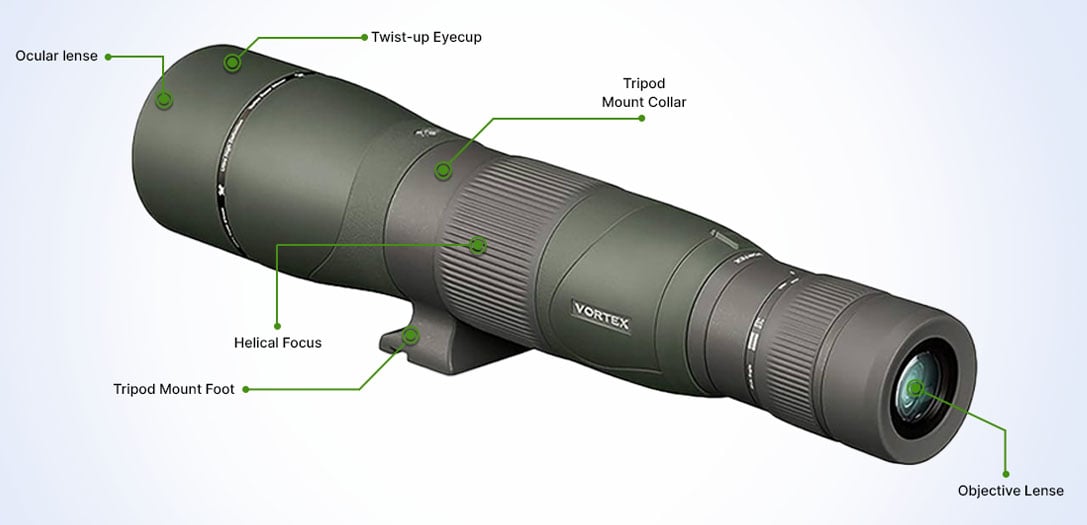Angled vs Straight Spotting Scopes
Which is Best?
By Patrick Long |

If you are a hunter that does a lot of glassing, a spotting scope is going to be one of your most important pieces of gear. A quality spotting scope can also cost a pretty penny too, so it might just be one of your most expensive pieces of gear. So it goes without saying that you want to pick the right scope for the job.
The first thing we look at before we buy a spotting scope is the magnification range. Paired with quality, you can expect the price to increase as your magnification range increases. A normal magnification range would be somewhere between 20 to 60x magnification, with some scopes going well above that. Your objective lens will be somewhere between 60mm and 85mm. That is a beefy scope, but that is what you need to see any detail on a target that is hundreds of yards away.
After you have decided on a magnification range and how much you would like to spend, the next most common question is if you should get an angled or straight spotting scope. It may seem like a simple decision, but the best scope design for you depends on how you hunt, and how comfortable you want to be. Manufacturers frequently make both straight and angled versions of their scopes for hunters to choose from, keeping all other factors like weight, price, and quality constant.
The Quick Comparison
Before we dive into it, here is the 30 second version of this article, complete with what each scope is best at in the table below.
In general, angled spotting scopes are going to be more comfortable to use in the field. Their viewing angle is more adjustable and versatile. That versatility also makes it easier to see steeper angels. Straight spotting scopes make transitioning from binoculars to your scope much easier, significantly improving target acquisition. Straight spotting scopes are also generally easier to work with and pack, and they are more natural to use if you are looking at an extreme up or down angle, or using it from a vehicle.
| Straight | Angled |
|---|---|
|
|
Viewing Angle
Seeing as you may be looking through your spotting scope for a little while, you want it to be comfortable to use. The angle between your head or neck and the eyepiece of the scope is known as the viewing angle. With an angled spotting scope, you have a very comfortable viewing angle that is around 45 degrees. It is extremely similar to--although not as extreme as--the angle you would use to look through a space telescope.
This is a very natural angle, and with a supported spotting scope on a tripod, the angle is very comfortable for the neck, and you can almost rest your head on the scope. An angled spotting scope makes looking up hill super easy, as it is just a matter of bending down a little farther, or raising your tripod. Although looking down is a bit tougher for both kinds of scopes. For the angled spotting scope, you can get better downward angles by lowering your tripod, or adjusting the cant of your scope so that the eyepiece isn't so high.
Angled scopes with a cant option are extremely versatile, and with the scope looking at a single point, you can rotate the cant to put the eyepiece nearly 270 degrees around that center point. You can get the other 90 degrees of rotation by simply flipping the scope over, although not all scopes will mount to a tripod that way. Straight scopes do not really benefit from having a cant option, because the perfectly symmetrical scope will be the same no matter how you rotate it. So if you want to look at steep angles with a straight spotting scope, you are going to have to put your head at steep angles, and work with your tripod.

The angle between you and the eyepiece of a straight spotting scope is zero degrees, so you will have to be level with it. As you might imagine, this means your tripod is going to have to be taller than it would be with an angled spotting scope. This also makes it tougher for multiple hunters to use the same spotting scope, because each person may need to adjust the tripod, which is a hassle.
Looking uphill is not impossible with a straight spotting scope, but the angle is a bit harder on the neck than what you would do with an angled spotting scope. To look up with a straight spotting scope, your neck is going to be leaned backwards, which can get uncomfortable pretty quickly. Although the straight spotting scope does have an advantage when you are looking at extreme angles, like directly down a mountain side. In this scenario, the straight angle is more natural to work with than an angled eyepiece.
Target Acquisition
If you are on a western hunt and you need to glass most of the day, chances are that you are going to be doing that with your binoculars, not a spotting scope. Binos do a better job at giving you a respectable amount of magnification, but a wider field of view, so you can spot targets better. After you find something interesting, then you whip out your spotting scope to look at it in more detail.
The problem you will run into there is the fact that you can lose an animal in that vast country just as fast as you found it. After you see it in your binos, making the transition to spotting scope, and finding the animal again can be tough. This is where the straight spotting scope has a bit of an advantage.
Picture this, you are standing there with your binoculars, and you find a mule deer that looks like a buck. You aren’t sure if he is big enough to chase, so you transition to your spotting scope to get a more detailed look at him. Seeing as you have an angled spotting scope, you will have to totally change the angle of your head, and the scope itself is going to be on a different plane than your binos were. So it is going to take you a few seconds or more to refind that deer, especially if he was moving or wasn’t standing next to some kind of landmark.
Another problem with that is that if you keep your binos on your tripod, and want to transition your spotting scope to your tripod instead, you will need to lower it. This will for sure put your spotting scope on a different plane than your binoculars, and add to your reacquisition time.
Alright, let's rewind a bit. Same scenario, but this time you have a straight spotting scope instead of an angled one. You see a nice mule deer buck, and there are definitely some antlers there, but is he a massive six by six, or just another forky? Well, as you take your binos off your tripod, you can put your straight spotting scope on and it will be in the exact same place, at the exact same angle.
You look through your straight spotting scope to see the buck has only taken a couple of steps because you didn’t have to waste too much time finding him in the scope, and good news, he could be your biggest buck to date. Better start covering some ground.
Tripod Profile & Sturdiness
As hunters, we want to be as inconspicuous as possible. One piece of gear that is the most likely to be seen by our prey is our tripod. If you have a big tripod all stretched out, it is going to make your profile more noticeable than it would be if you were using a little 2 foot tripod while sitting on the ground.
A straight spotting scope forces you to make your tripod a bit taller than it would be if you used an angled scope. I am not saying that this is going to directly correlate to spooking more deer or elk, but it certainly can’t help. A taller tripod is also less sturdy and harder to adjust.

It may not make the difference between going home with a elk and going home empty handed, but I can certainly say that I rather have a shorter tripod that is more manageable and that I know isn’t going to fall over with my expensive scope on it if I don’t pay attention to it while I am glassing with my binos. Plus, staying as low profile as possible is always a good thing when hunting.
Performance Difference
The best part about this angled vs straight spotting scope debate is that it is based purely on personal preference. There is absolutely zero performance difference between the two types of scopes. When I first started researching this topic, I thought there may be a slight difference because of how the physics of the two scopes was different, with the angled scope needing to reflect light off mirrors, but no. We have that technology pretty well figured out.
As a matter of fact, companies often produce the exact same scope with the exact same specs in both an angled and straight configuration. So if you see any one else saying that one of these types of scopes is fundamentally better than the other, they are just plain wrong. It is just a matter of personal preference.
To me, I like the versatility of the angled scope, and I think most hunters would benefit from its strengths more often than you would the strengths of the straight spotting scope. Although that is likely a consequence of how I hunt, and the straight scope might be better for you and the way you hunt. Like most things in hunting, there is no right or wrong answer, just pick which one sounds best for you in the majority of situations, and get out there and put it to use!